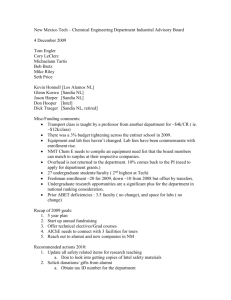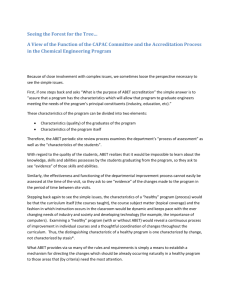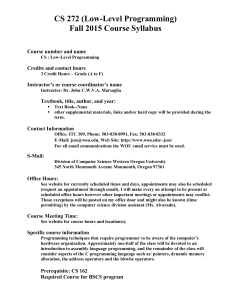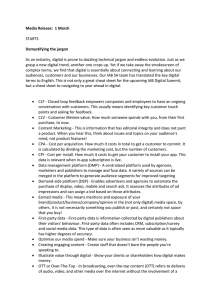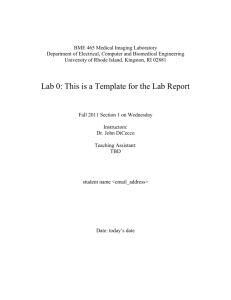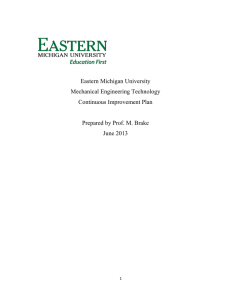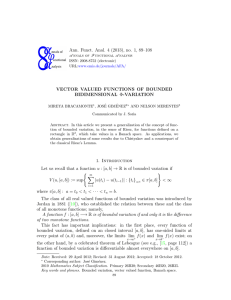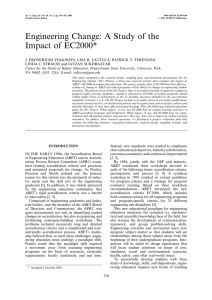EE IAB
advertisement
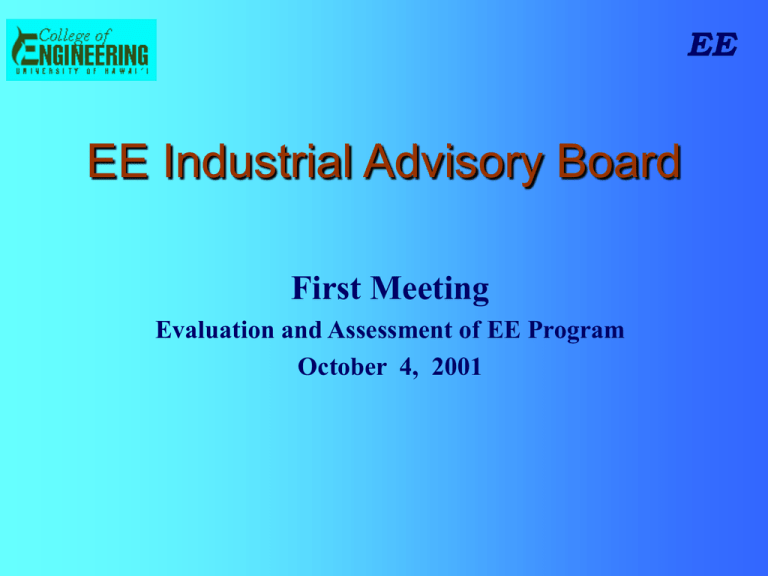
EE EE Industrial Advisory Board First Meeting Evaluation and Assessment of EE Program October 4, 2001 EE ABET EC2000 Accreditation Board for Engineering Technology Engineering Criteria 2000 Revolutionary change to accrediting engineering programs (mandatory from Sept. 2001). Focus on results of engineering education rather than curriculum. Setting educational objectives Outcome assessment for evaluation Soft (nontechnical) skills should not be neglected Continuous improvement is necessary EE Objectives of IAB Assessment tool for our EE program Receive inputs from constituents (industry and alumni) Visits will serve as trial visits for ABET visit in Fall, 2003 EE Tasks for IAB Visit UH EE program at regular intervals. First meeting (agenda set by EE dept.). Future meetings IAB will have control over agenda. Form IAB organization and charter. Evaluate and assess EE program. Submit written report and fill out survey summarizing findings. EE Summary of meetings today Morning: introductions, overview, IAB organization, what we have done to prepare for ABET, discussions. Lunch: IAB only Afternoon: snapshot of EE program, discussion, and filling out report and survey. Flexibility for some changes and additional meetings. EE EE Dept. Overview One of three departments (CE, EE, ME) in College of Engineering. Formed in 1959 with 3 professors. Only EE program in state of Hawaii. Offers full complement of degrees: B.S., M.S., Ph.D. Known for quality undergraduate program: many graduates have had very successful careers in Hawaii and on mainland. Quality research program in targeted areas (e.g. networking and communications (Aloha)). EE Current EE Personnel Faculty: 17 full time, 4 emeritus, several adjunct faculty (down from 24 full time three years ago). Hired two faculty in last year and have verbal commitments for two more faculty to start 1/1/02. Students: 307 undergraduate students and 65 graduate students (rates slightly higher for UG students and lower for graduate students). Graduation rates: 40-50 UG students /year, 25 advanced degrees/year Staff: 3 secretaries, 2 technicians, 1 computer support, 1 admin. asst., student help. EE EE Areas Computer Engineering: hardware and software Electrophysics: circuits, devices, microwaves, optics Systems: communications, controls, networking, power, signal processing Currently have faculty shortages in computer engineering area and circuits EE EE Facilities Computer labs (EE and COE) EE instructional labs EE research labs Instructional facilities: Don Kim lab, new distance learning facility EE EE Research Government funding (NSF, DoD) Industry funding (Spirent-Adtech, NEC, TRW) Approximately $1M in last year (down from recent years) Focus more on group and multidisciplinary research, Hawaii Center for Advanced Communications. Currently more undergraduate research EE EE Awards 5 present and former IEEE Fellows. 9 present and former NSF PYI/NYI/Career Award winners. At least 9 faculty have been involved with startup companies or new IPOs. One current faculty received University teaching award. Former faculty member won Japan prize. 2001 graduate won HKN’s highest student prize. EE Summary of packet materials IAB documents – IAB organization (membership, charter, EE UG vision) – ABET EC 2000 Objectives Basic level criteria (8 criteria) UH EE ABET materials – ABET program assessment guide – Instructional program – Assessment surveys EE overview IAB agenda (updated agenda) EE ABET EC2000 Objectives Assure that graduates of an accredited program are adequately prepared to enter and continue the practice of engineering. Stimulate the improvement of engineering education Encourage new and innovative approaches to engineering education and its assessment Identify accredited programs to the public EE ABET EC2000 Criteria Students Program Educational Objectives Program Outcomes and Assessment Professional Component Faculty Facilities Institutional Support & Financial Resources Program Criteria Assessment Cycle A two-loop process EE EE Programs Outcomes and Assessment a) An ability to apply knowledge of mathematics, science and engineering appropriate to the discipline b) An ability to design and conduct experiments, analyze and interpret data c) An ability to design a system, component or process to meet desired needs d) An ability to function on multidisciplinary teams e) An ability to identify, formulate, and solve engineering problems f) An understanding of professional and ethical responsibility EE Program Outcomes and Assessment continued g) An ability to communicate effectively h) The broad education necessary to understand the impact of engineering solutions in a societal context i) A recognition of the need for, and an ability to engage in life-long learning j) A knowledge of contemporary issues k) An ability to use the techniques, skills, and modern engineering tools necessary for engineering practice EE UH EE ABET Preparation Overview of mission, objectives, and outcomes Discussion of assessments methods in place Evaluation of data and closing the loop EE EE Mission Statement The mission of the Dept. of EE is to provide quality education, research and service to our constituents. Major goals of the dept. are: 1) Educate a new generation of Electrical Engineers to meet the challenges of the future. 2) Create, develop, and disseminate new knowledge. 3) Promote a sense of scholarship, leadership, and service among our graduates. EE Program Assessment Guide Program objectives Program outcomes Correlation tables – Objectives vs. outcomes – Resources and strategies vs. outcomes – Assessment methods vs. outcomes EE Assessment methods developed Course syllabus and objectives Student evaluations Graduation surveys IAB Student Advisory Board EE Closing the loops Objectives and outcomes committee – ABET committee – Curriculum committee – External industry member (from IAB) – Student member (from SAB) Goals of committee – Insure educational objectives are consistent with mission of dept. and UH. – Continual evaluation and assessment of outcomes to determine where educational objectives are met and can be improved through modifications to curriculum and processes. – Oversee collection and evaluation of assessment data. – Coordinate preparation of accreditation visits. Assessment Cycle where we are EE EE EE Flowchart EE Design Courses EE196 EE296 EE396 EE496 Provide students with design experience, integrating knowledge from different courses, written and oral communication skills, working in teams, consideration of other nonengineering skills EE196: optional freshman design course EE296/396: required sophomore/junior design course EE496: senior capstone design project EE Computer Courses EE Electrophysics courses EE Systems Courses EE Student Design Projects David Lam: EE 296 – Remote control robot Mike Hall: EE 396 – Tunable external cavity laser John Mazotta: EE 496 – Capstone design project Darren Ghoshi: Group undergraduate wireless transceiver project Aaron Ohta: Extracurricular project- Micromouse

